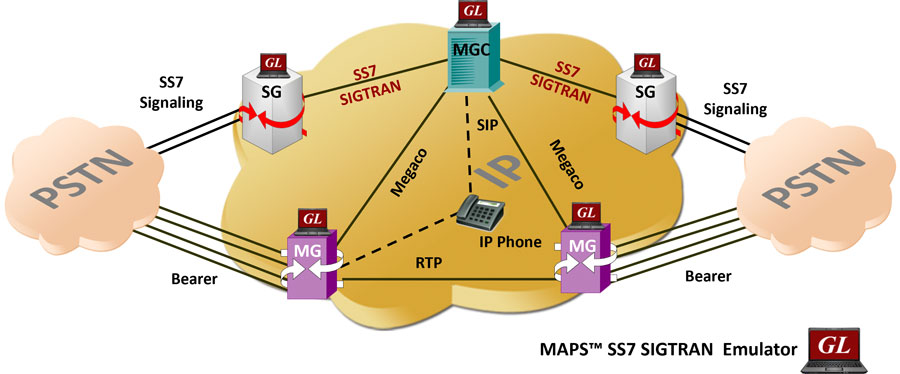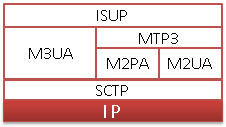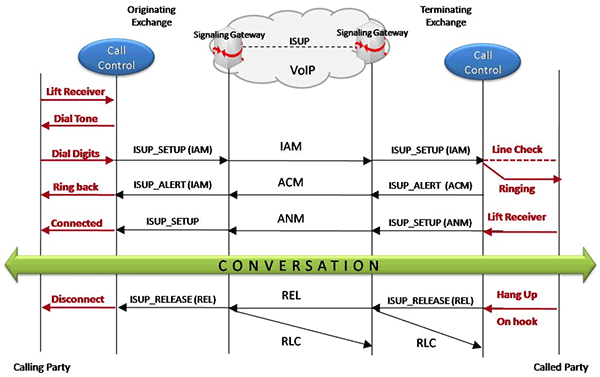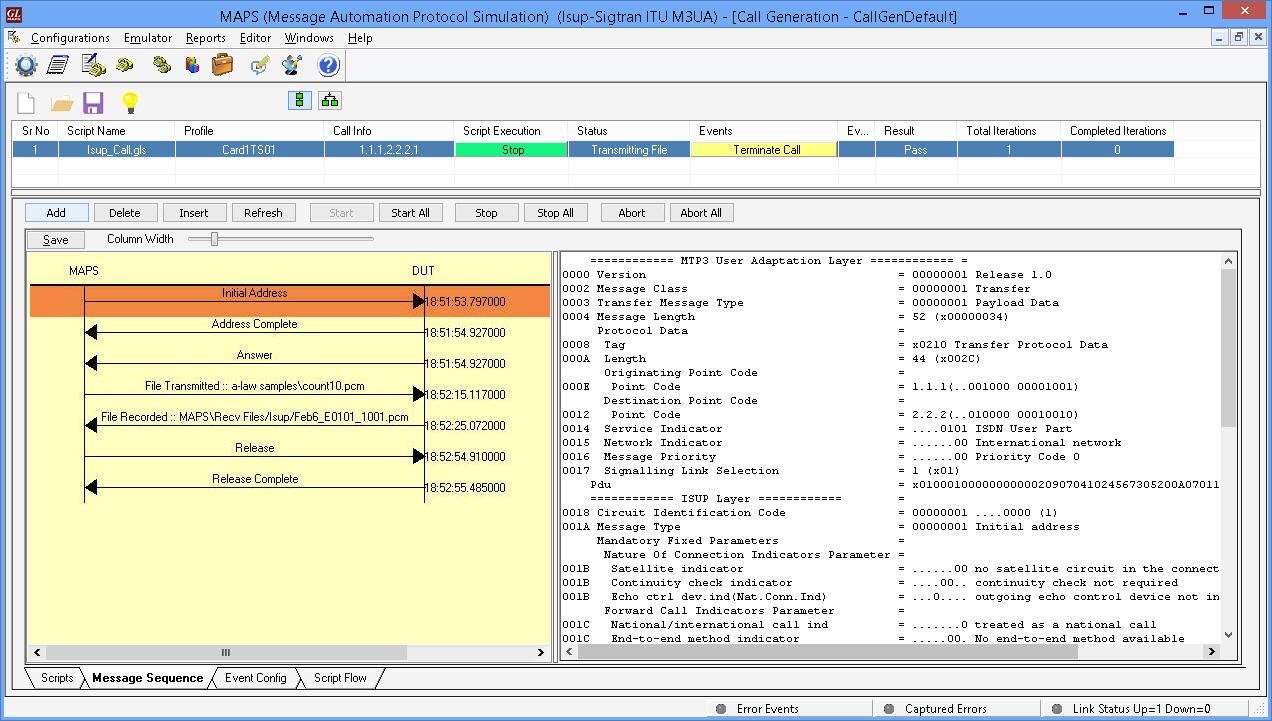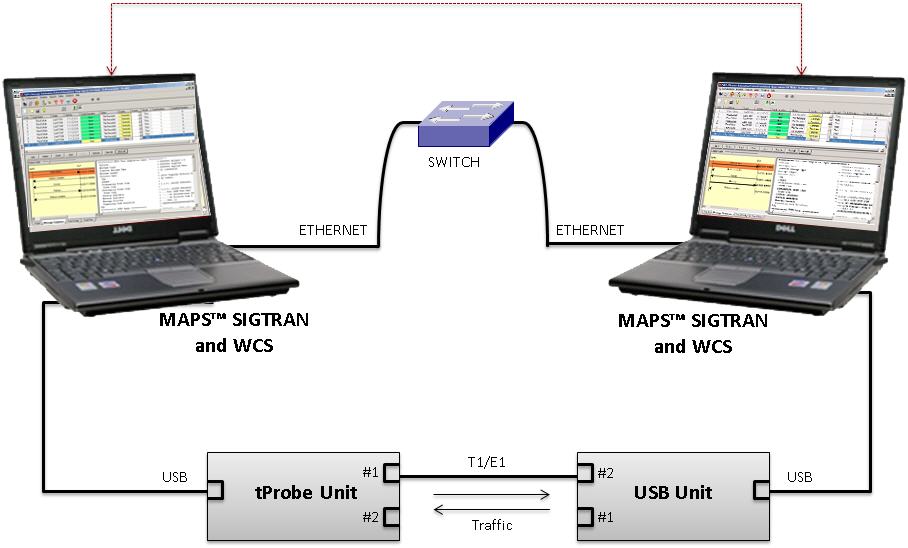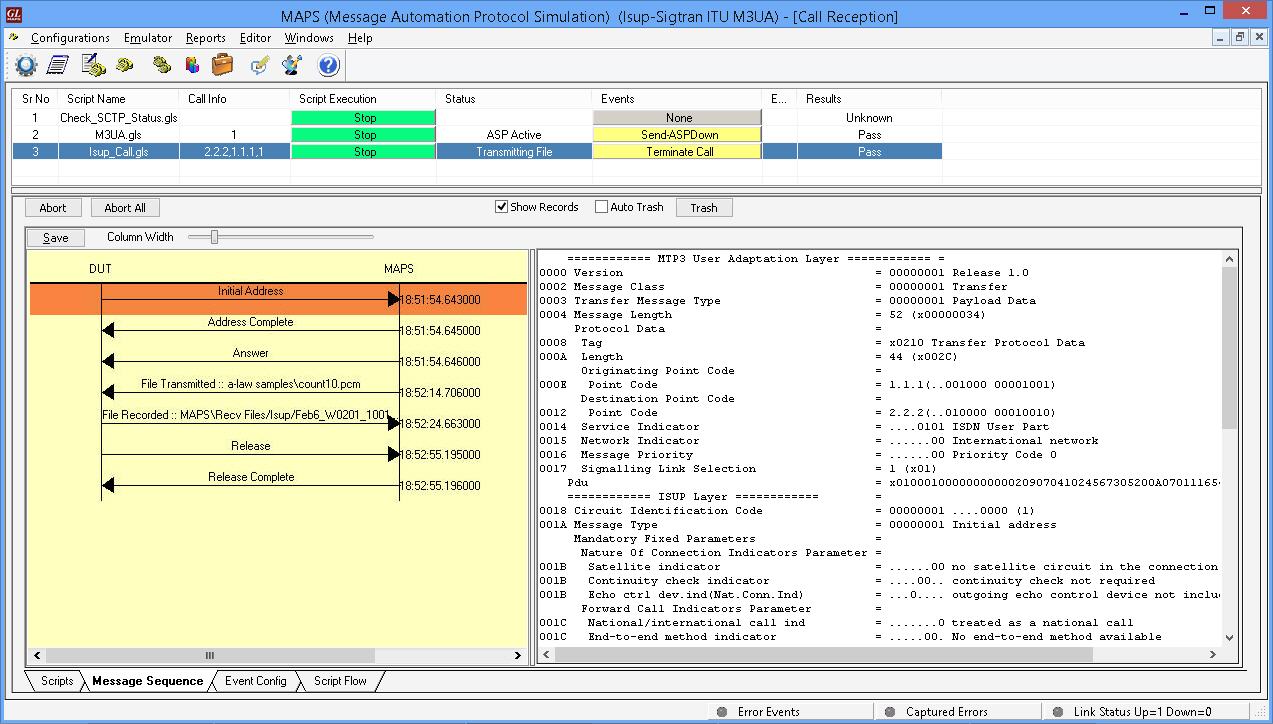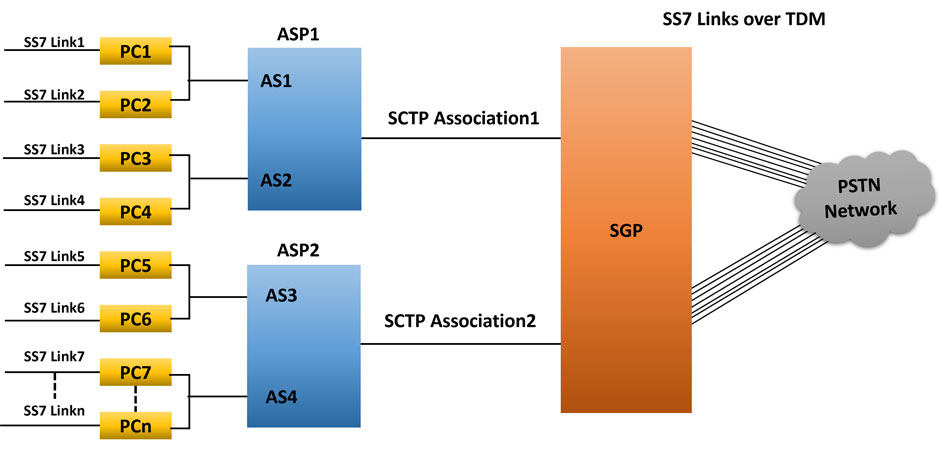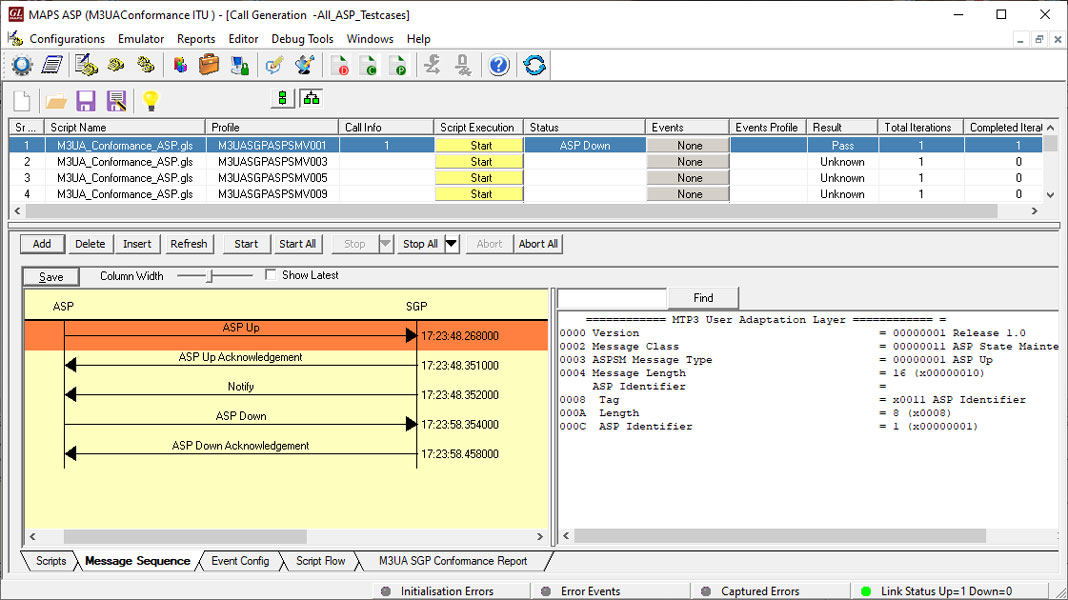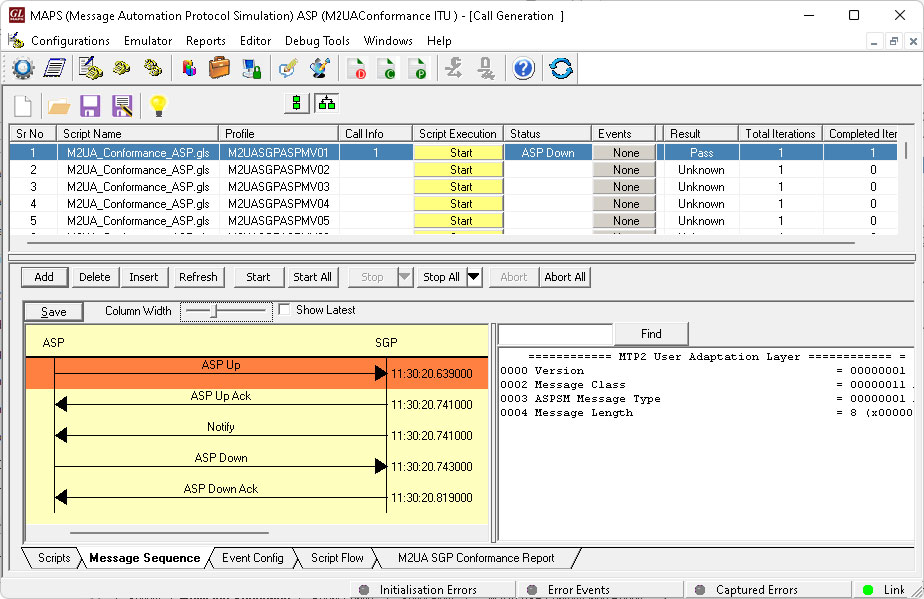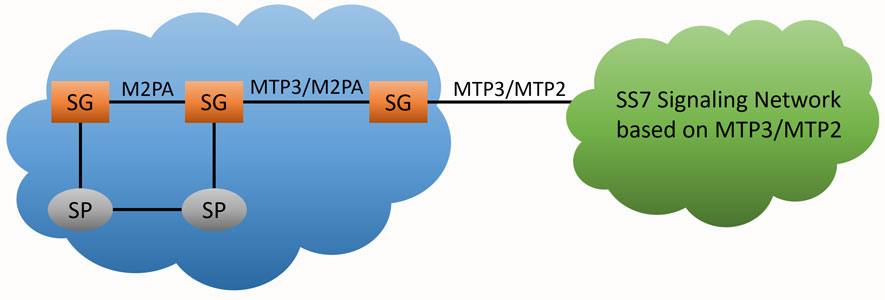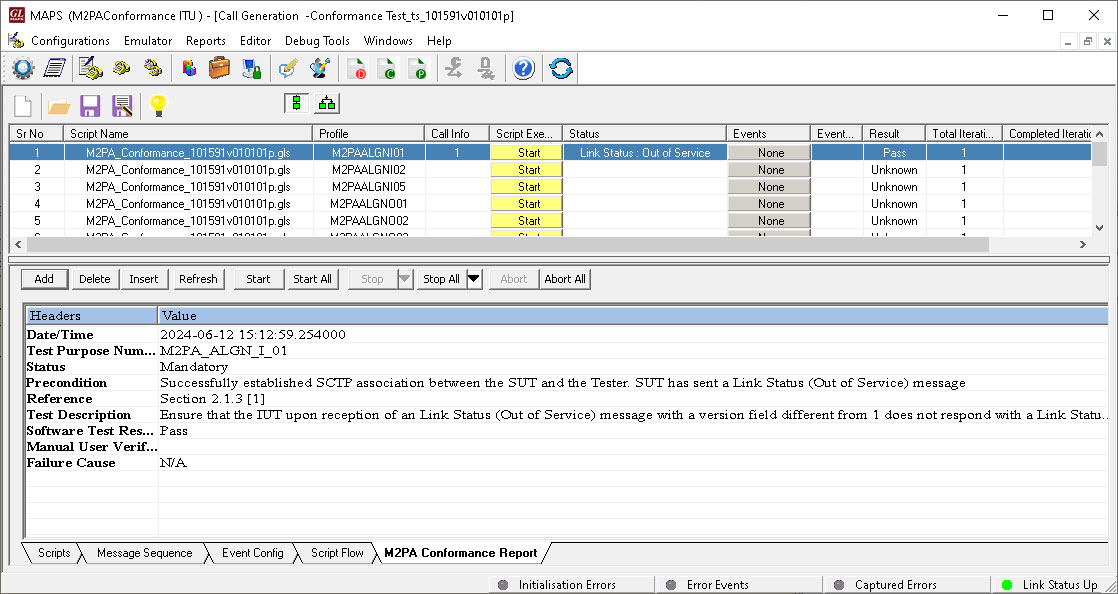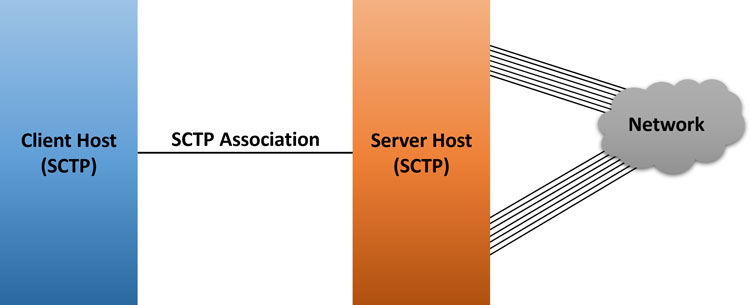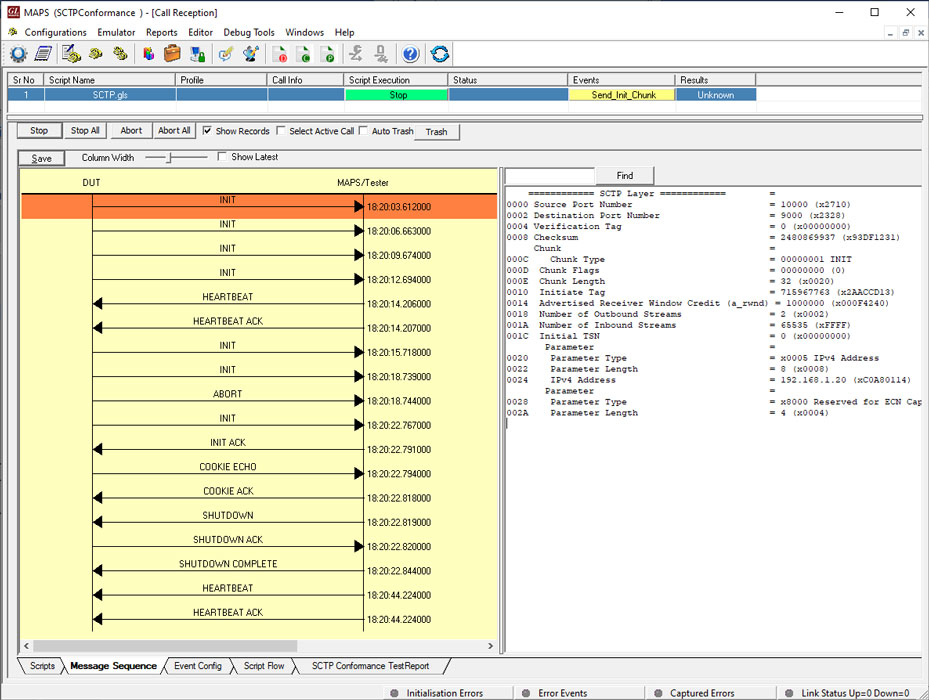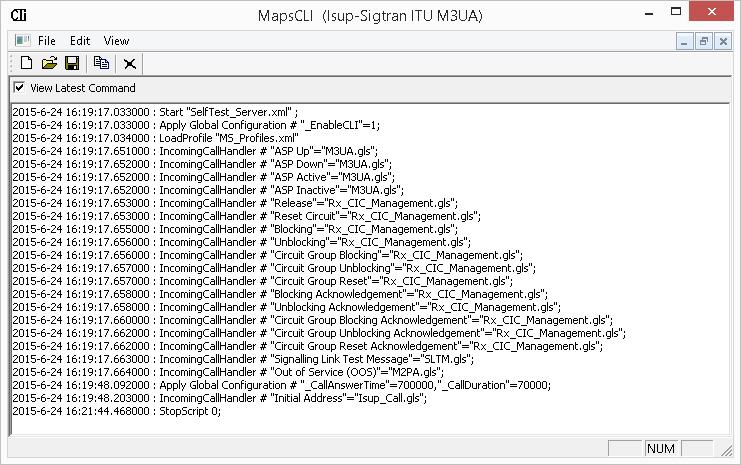MAPS™ SIGTRAN (SS7 over IP) Protocol Emulator
Simulate SS7 protocol over IP (SIGTRAN) between Signaling Gateway (SG) and Media Gateway Controller (MGC), interworking between TDM and IP network.
Brochure Request a Demo / QuoteBackground
SIGTRAN protocols are an extension of the SS7 protocol family, but carried over IP. A Signaling Gateway (SG) translates the SS7 TDM layers to SIGTRAN IP format. It supports the same application and call management functions as SS7 but uses two protocol layers on top of Internet Protocol (IP): Stream Control Transport Protocol (SCTP) and M3UA (MTP3 User Adaptation Layer.
M3UA enables SS7 protocol's User Parts (e.g. ISUP, SCCP and TUP) to run over IP instead of TDM lines.
ISUP, or ISDN User Part, is used to set up and release calls through the PSTN. In an IP network, ISUP is carried as payload by SCTP, as are SCCP and TUP. When a call is terminated in the IP Network, a soft switch translates SIGTRAN into SIP or MGCP signaling. If the call is terminated in the PSTN, an SG reconverts SIGTRAN to SS7 TDM.
Overview
Message Automation & Protocol Simulation (MAPS™) is a powerful protocol test simulation platform supporting a wide range protocols such as SIGTRAN (SS7 over IP), SS7 over TDM (T1 E1), ISDN over TDM (T1 E1), GSM-A & GSM-Abis over TDM, Megaco, SIP, and MGCP over IP.
GL's MAPS™ SIGTRAN (PKS130) is an advanced protocol simulator/tester for SS7 simulation over IP Networks. It can simulate a Signaling Gateway and Softswitch ISUP signaling specification as defined by ITU-T standards. The application supports testing network elements, error tracking, regression testing, load testing/call generation and generation of high volumes of ISUP traffic. MAPS™ SIGTRAN functionality covers the ITU and ANSI variant of SS7 implementing M2UA, M2PA, M3UA, SCTP, and ISUP protocols. It is able to run pre-defined test scenarios against ISUP test objects in a controlled and deterministic manner.
The application is available as
- MAPS™ SIGTRAN Emulator (PKS130)
- MAPS™ SIGTRAN Conformance Scripts (requires additional license)
With additional licensing, MAPS™ SIGTRAN supports Conformance Scripts for M2PA(PKS130), M2UA(PKS130), M3UA(PKS130), and SCTP(PKS129) protocols. For more details, contact GL Communications.
The supported conformance scripts are designed for compliance and functional tests, enabling accurate and reliable validation of test objects in accordance with ITU-T standards Q.761-764 and Q.784. These scripts are suitable for manufacturers, network operators, and service providers, addressing all stages of the development cycle from initial development and regression testing to type approval and acceptance testing.
GL supports following conformance suites:
- MAPS™ M3UA Conformance
- MAPS™ M2UA Conformance
- MAPS™ M2PA Conformance
- MAPS™ SCTP Conformance
MAPS™ application supports powerful utilities like Message Editor and Script Editor which allow new scenarios to be created or existing scenarios to be modified using ISUP messages and parameters.
MAPS™ SIGTRAN in an SS7overIP environment connects to traditional SS7 nodes or IP-enabled signaling nodes and offloads TDM SS7 traffic to IP networks. It is also capable of operating in an environment that interworks between TDM and SS7overIP. It supports TDM traffic simulation over IP networks. Various traffic types include File, Digits, Tones, FAX, IVR, Dynamic VF, and Voice Quality Testing. MAPS™ can be configured to auto start the traffic over SS7 signaling or manually define traffic at run time.
GL also offers MAPS™ Media Gateway Controller (MGC - PKS300), a multi interface simulator, which can be configured with Signaling Gateway (SG) to handle call control and Media Gateway (MG) in the network to perform end-to-end test scenario by simulating SIGTRAN, MEGACO and MGCP interfaces. GL recommends purchasing additional MG simulation with appropriate RTP licenses for high density traffic simulation.
Also available is an independent GUI based SIGTRAN (SS7 over IP) Protocol Analyzer for online capture and decode of the signaling in real-time both during tests and as a stand-alone tracer for live systems.
Main Features
- SS7 simulation over IP
- User-friendly GUI for configuring the SS7 M3UA, M2PA, M2UA, SCTP Layers
- User Configurable Signaling Links
- Supports ASP (Application Server Process) or SGP (Signaling Gateway Process) termination types over IP
- Supports conformance testing for M2PA, M2UA, M3UA, and SCTP protocols
- CIC Management features: Circuit Blocking & Unblocking, Circuit Group Blocking & Circuit Group Unblocking, Circuit Reset & Group Reset
- Circuit Mapping features: CIC mapped to Timeslot (Timeslot Based / CIC Based), and Only CIC (Without traffic, user can provide CIC range for each SSP, CIC is generated randomly or User Provided)
- Access to all ISUP Message Parameters Initial Address, Subsequent Address, Release messages, and more
- User controlled access to optional ISUP parameters such as timers
- Subsequent Address Message (SAM) configurations available
- Generates and processes SIGTRAN valid and invalid messages.
- Supports calls suspend, call resume, call hold and call retrieve.
- Offloads TDM Traffic (digits, voice file, tones, IVR, FAX, Dynamic VF, and Voice Quality) over IP
- Supports SIGTRAN conformance testing (requires additional license)
- With MAPS™ MGC Multi-interface (requires additional licenses), both end-to-end signaling (using SIGTRAN) and RTP media (using MEGACO) simulation can be performed
- Supports Client-Server functionality requires additional license; clients supported are Python and Java
- Automation, Remote access, and Schedulers to run tests 24/7
Supported Protocols Standards
MAPS™ M3UA Conformance
M3UA (MTP Level 3 User Adaptation Layer) is a protocol defined by the IETF SIGTRAN working group in RFC 4666, replacing RFC 3332. It enables the transport of SS7 (Signaling System 7) signaling messages over IP networks using the Stream Control Transmission Protocol (SCTP). M3UA acts as a bridge between traditional SS7 networks and IP-based networks, used between a Signaling Gateway (SG) and a Media Gateway Controller (MGC), an IP-resident database, or between two IP-based applications.
M3UA operates at the network layer, establishing reliable M3UA associations between signaling endpoints such as signaling gateways, signaling endpoints, or application servers. It allows SS7 User Parts (e.g., ISUP, SCCP, and TUP) to run over various network technologies, eliminating the need for traditional telephony equipment and greatly improving network scalability.
The MAPS™ M3UA Conformance Test Suite is designed according to IETF RFC 3332 specifications to ensure compliance with M3UA protocol standards. It includes over 100 test cases and built-in conformance scripts (*.gls) that validate the ASP's adherence to the M3UA interface as specified by 3GPP standards.
The test suite can be configured to function as an ASP, using conformance scripts to simulate various network-side procedures. This setup supports testing a range of test scenarios such as ASP State Maintenance Procedures, ASP Traffic Maintenance Procedures etc., and automates the entire testing process for the Signaling Gateway (SGP), which is the Device Under Test (DUT).
MAPS™ M2UA Conformance
M2UA, or MTP Level 2 User Adaptation Layer, is defined by the IETF SIGTRAN working group in RFC 3331. It is a protocol that enables the transport of SS7 (Signaling System 7) MTP3 layer signaling messages over IP networks using the Stream Control Transmission Protocol (SCTP). M2UA provides an MTP3/MTP2 interface boundary, typically used between a Signaling Gateway (SG) and a Media Gateway Controller (MGC).
GL's MAPS™ M2UA Conformance Test Suite is developed in accordance with IETF RFC 3331 specifications to ensure compliance with M2UA protocol standards. It includes over 100 test cases and built-in conformance scripts (*.gls) to validate the ASP's adherence to the M2UA interface as specified by 3GPP standards.
The MAPS™ M2UA Conformance Test Suite can be configured to function as an ASP, using conformance scripts to simulate various network-side procedures. The setup automates the entire testing process for the Signaling Gateway (SGP), which is the Device Under Test (DUT). This supports testing a range of scenarios such as ASPM (Application Server Process Management) state and traffic transactions management, Interface Identifier Management (IIM), and MTP2 User Adaptation.
MAPS™ M2PA Conformance
M2PA, or MTP Level 2 Peer Adaptation Layer, is defined by the IETF SIGTRAN working group in RFC 4165. It provides MTP3 layer services for SS7 using the Stream Control Transmission Protocol (SCTP). M2PA establishes connections between two SS7 nodes, each with its own SS7 Point Code and identical functionality. Primarily, M2PA replaces B-, C-, and D-links and can also be used with A-links to connect Service Switching Points, Signaling Control Points, Home Location Registers, and other endpoints. It is particularly useful for connecting points that handle time-sensitive call-related data, such as ISUP calling data.
GL's MAPS™ M2PA Conformance Test Suite is developed to ensure compliance with M2PA protocol standards as specified in IETF RFC 4165. It includes over 40 test cases and built-in conformance scripts (*.gls) to validate M2PA conformance in the Service Switching Point (SSP) interface according to 3GPP standards.
The MAPS™ M2PA Conformance Test Suite can be configured to function as an SSP, utilizing conformance scripts to simulate various network-side procedures. This setup supports testing a range of scenarios such as link state control message signal units, Transmission failure, Transmission and Reception control etc., and automates the entire testing process for the SSP, which is the Device Under Test (DUT).
MAPS™ SCTP Conformance
SCTP, or Stream Control Transmission Protocol, is defined by the IETF working group in RFC 9260. It operates at the transport layer of the Internet Protocol (IP) and is a connection-oriented network protocol used for transmitting multiple data streams simultaneously between endpoints. SCTP combines the message-oriented features of the User Datagram Protocol (UDP) with the reliable, in-sequence transport and congestion control of the Transmission Control Protocol (TCP).
GL's MAPS™ SCTP Conformance Test Suite is developed to ensure compliance with SCTP protocol standards as specified in IETF RFC 9260. It includes over 100 test cases and built-in conformance scripts (*.gls) to validate conformance in the SCTP interface according to 3GPP standards.
The MAPS™ SCTP Conformance Test Suite can be configured to operate as a server, utilizing conformance scripts to simulate various network-side procedures. This setup supports testing a range of scenarios such as Association, Termination, Fault Handling, Duplicate Messages, Invalid Message Handling etc., and automates the entire testing process for the SCTP which is Device Under Test (DUT).
A Typical MAPS™ Sigtran Test System
A typical MAPS™ Sigtran consists of:
- A TCL interface communicating over TCP/IP to a Rack PC with T1/E1 Analyzer Software
- The Rack PC consists of MAPS™ Client IFC, MAPS™ CLI Server, T1/E1 Analyzer Software (including Windows Client Server software) and a Dual T1/E1 Card
- A patch panel for RJ-11 connections to the outside world (DUT)
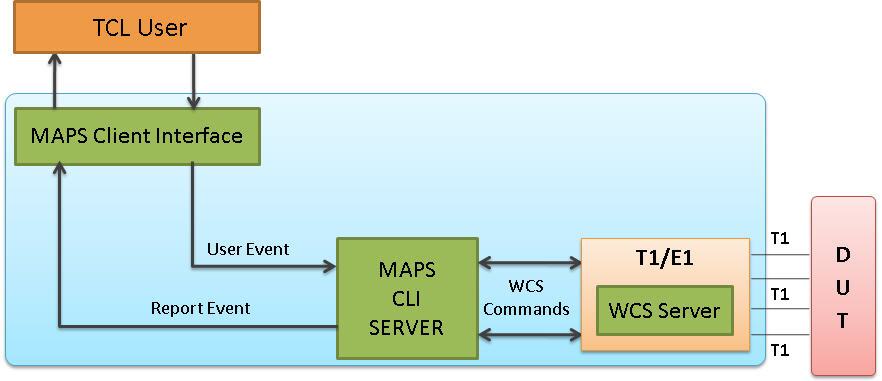
- TCL Client – Acts as User Interface, which executes TCL Scripts.
- MAPS TCL Interface (MAPS Client IFC) – acts as an interface between MAPS™ CLI Server and its client TCL. It interprets the TCL Commands and forms the appropriate command as understood by MAPS CLI Server and vice versa.
- MAPS™ CLI Server is an executable that inherits all features of MAPS™ without GUI. It listens to a TCP message socket to receive and execute commands from client and sends the responses back to client.
T1/E1 Windows Client Server - Windows Client/Server software performs all SS7 emulation primitives including signaling, tone detection, call progress signals, file transfer, and many more functions.
TCL application consists of three functional modules: Tool Command Language (Tcl) Client and Script, MAPS™ Tcl Interface, and MAPS™ Server
In CLI, MAPS™ Server constitutes two server modules, namely MAPS™ CLI server and GL WCS server.
- MAPS™ CLI Server
MAPS™ CLI Server is an executable which inherits all features of MAPS™ without the graphical user interface. Instead it listens to TCP message socket to receive and execute commands from the client and sends the responses back to the client.
- GL's Windows Client Server
GL's Windows Client/Server software allows the user of T1/E1 analysis cards the capability of remote operation, automation, and multi-site connectivity.
TCL client receives report event from the CLI server as shown in the figure below.
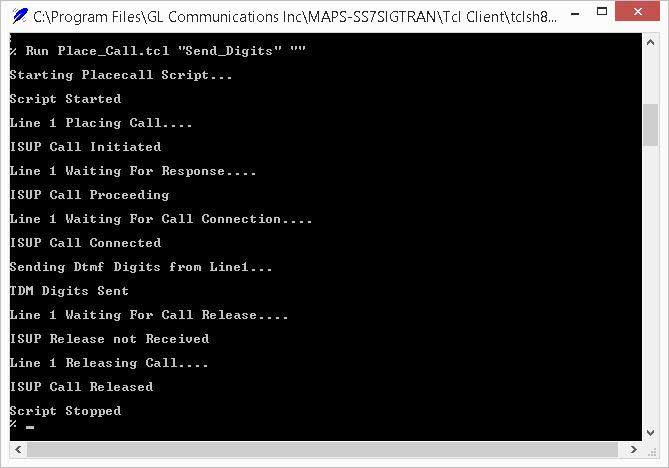
TCL client placing the call
Resources
Please Note: The XX in the Item No. refers to the hardware platform, listed at the bottom of the Buyer's Guide, which the software will be running on. Therefore, XX can either be ETA or EEA (Octal/Quad Boards), PTA or PEA (tProbe Units), XUT or XUE (Dual PCIe Express) depending upon the hardware.
| Item No. | Item Description |
| PKS130 | MAPS™ SIGTRAN Emulator |
| Brochures |
| Wireless Networks Lab Solutions |
